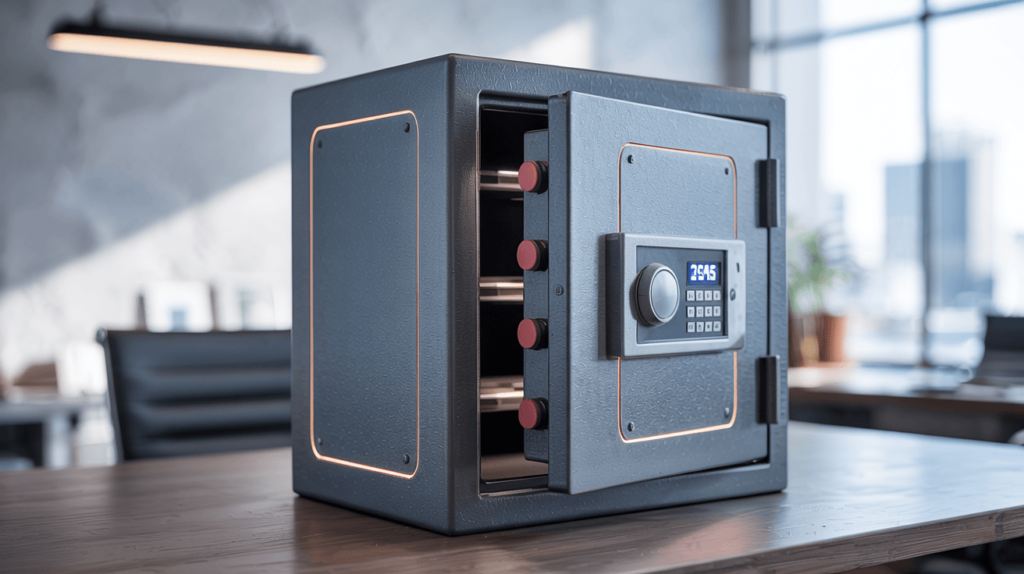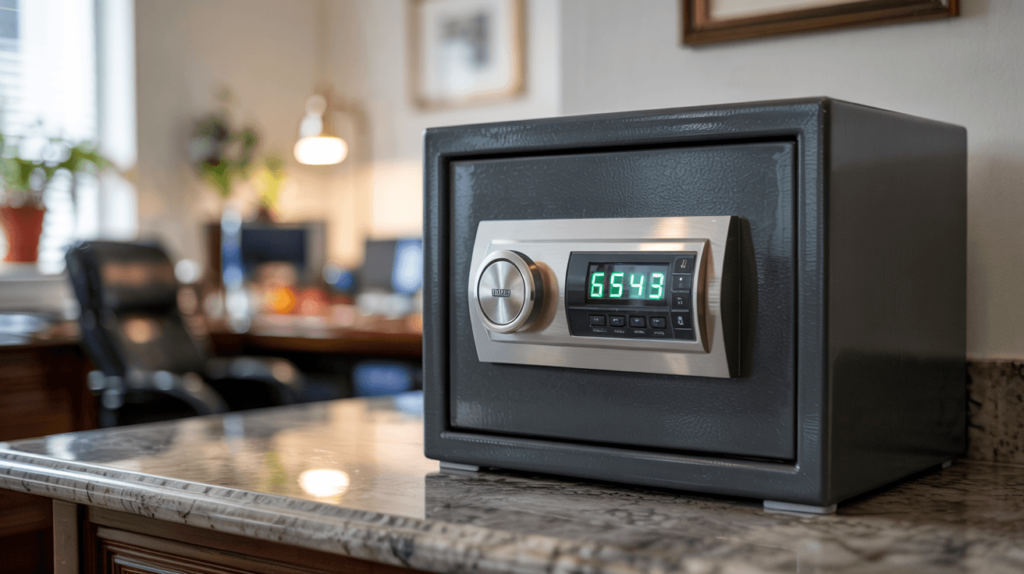In an era where unexpected disasters can strike at any moment, protecting your most important documents and valuables is non-negotiable. A fireproof safe box offers reliable protection against one of the most common and devastating threats to your possessions – fire. This comprehensive guide will walk you through everything you need to know about selecting, using, and maintaining the perfect fireproof safe for your home or business.
1. What Is a Fireproof Safe Box?
A fireproof safe box is a specially designed container that protects contents from high temperatures during fires. But here’s the kicker: these safes don’t just resist fire – they maintain internal temperatures low enough to protect paper documents, digital media, and other sensitive items. Unlike standard safes, fireproof models incorporate specialized insulation materials that activate under extreme heat.
Key components include:
- Steel outer shell (typically 12-10 gauge)
- Fire-resistant composite insulation
- Heat-activated door seals
- Moisture-releasing materials
- UL-rated locking mechanisms

The SentrySafe SFW123DSB demonstrates these features perfectly, with its UL Class 350 fire rating protecting paper documents for up to 1 hour at 1700°F exterior temperatures.
2. How Does a Fireproof Safe Work?
The science behind fireproof safes is fascinating. Ready for the good part? These safes don’t just block heat – they actively manage temperature through chemical reactions in their insulation.
Here’s how the protection works:
- Outer steel shell reflects initial heat
- Insulation layers absorb and dissipate heat
- Moisture in insulation turns to steam when heated
- Steam creates a cooling barrier inside
- Door seals expand to prevent heat penetration
| Component | Function | Protection Level |
|---|---|---|
| Outer Shell | First line of defense | Reflects radiant heat |
| Insulation | Absorbs and dissipates heat | Maintains internal temp |
| Door Seal | Expands when heated | Prevents heat penetration |
| Moisture Layer | Creates cooling steam | Regulates internal climate |
3. Why Do You Need a Fireproof Safe?
Fire poses a greater threat than many realize. This is where it gets interesting: According to NFPA, U.S. fire departments respond to a fire every 23 seconds, with home fires causing $7.2 billion in property damage annually.
Critical reasons to invest:
- Document Protection: Birth certificates, property deeds, and wills are irreplaceable
- Financial Security: Protect cash, bonds, and financial records
- Digital Preservation: Backup hard drives and USB storage
- Insurance Compliance: Many policies require proper document storage
- Peace of Mind: Knowing your most important items are safe
A 2023 insurance study showed homeowners with fireproof safes recovered important documents 85% more often after fires compared to those without proper protection.
4. What Are the Different Fireproof Ratings?
Understanding fire ratings is crucial. What’s the real story? Not all fireproof safes offer equal protection, and ratings tell you exactly what to expect.
Key rating systems:
- UL Class 350: Protects paper (internal temp stays below 350°F)
- UL Class 125: Protects digital media (below 125°F)
- ETL Verified: Similar to UL but different testing body
- JIS Standard: Japanese industrial standard
5. What Can You Store in a Fireproof Safe?
While fireproof safes protect many items, don’t overlook this: Some objects shouldn’t be stored in them due to temperature sensitivity.
Ideal contents:
- Paper documents (passports, deeds, certificates)
- Digital media (external drives, USBs)
- Cash and important receipts
- Photographs and negatives
- Medication requiring temperature stability
Items to avoid:
- Flammable liquids
- Perishable foods
- Explosives or ammunition
- Extremely heat-sensitive electronics

6. How to Choose the Right Size Fireproof Safe?
Selecting the proper size requires careful planning. Here’s a pro tip: Always plan for future storage needs, not just current items.
Size selection guide:
- Inventory all items needing protection
- Measure largest item dimensions
- Add 30% space for future additions
- Consider organizational needs
- Verify external dimensions fit your space
Common size categories:
- Small (0.5-1.2 cu ft): Documents, small valuables
- Medium (1.2-2.5 cu ft): Added media storage
- Large (2.5+ cu ft): Bulk document storage
7. What Security Features Complement Fireproofing?
While fire protection is crucial, let’s cut through the noise: Your safe needs burglary protection too.
Essential security features:
- Lock Types: Biometric, combination, or dual-key
- Bolt Size: Minimum 1″ diameter locking bolts
- Hinge Protection: Internal or protected hinges
- Pry Resistance: Reinforced door edges
- Waterproofing: Many fireproof safes include this
The Honeywell 1108 demonstrates this perfectly with its UL-rated fire protection combined with digital keypad and backup key access.
8. Where Should You Place a Fireproof Safe?
Location significantly impacts performance. The truth is: Even the best safe can fail if installed improperly.
Ideal placement:
- Ground floor locations
- Interior walls (away from exterior heat)
- Away from potential fuel sources
- Easily accessible in emergencies
- Secured to floor or wall studs
A fire safety study found properly placed safes had 92% better protection rates than poorly located units.
9. How Much Does a Quality Fireproof Safe Cost?
Investing in protection requires budgeting. Consider these price ranges:
| Type | Price Range | Protection Level |
|---|---|---|
| Entry-Level | 150−150−300 | 30 min fire protection |
| Mid-Range | 300−300−800 | 1-2 hour protection |
| Professional | 800−800−2,000 | 2+ hours, media protection |
| Commercial | $2,000+ | Maximum protection |
10. What Are the Best Fireproof Safe Brands?
After extensive testing, these brands lead the market:
- SentrySafe – Best overall protection
- Honeywell – Great value options
- FireKing – Premium document protection
- Barska – Excellent media safes
- First Alert – Budget-friendly choices
11. How to Maintain Your Fireproof Safe?
Proper care extends safe life. Key maintenance tasks:
- Monthly lock checks
- Annual seal inspections
- Biannual cleaning
- Immediate attention to any damage
- Regular battery changes (electronic models)
12. Can Fireproof Safes Be Damaged?
While extremely durable, important note: No safe is indestructible.
Potential damage sources:
- Extreme prolonged heat exposure
- Physical impact during fires
- Water damage if not waterproof
- Improper maintenance
13. What Are Common Mistakes to Avoid?
Steer clear of these errors:
- Choosing size too small
- Ignoring burglary protection
- Poor placement decisions
- Neglecting maintenance
- Overloading safe capacity
14. How Does Fireproofing Affect Safe Use?
Understand these trade-offs:
- Weight: Fireproof safes are heavier
- Access: May be slightly slower
- Cost: Premium for protection
- Space: Insulation reduces interior space
15. Where to Buy a Reliable Fireproof Safe?
Purchase from:
- Manufacturer authorized dealers
- Specialty security retailers
- Reputable online stores
- Office supply chains
FAQs About Fireproof Safe Boxes
Q1: What is a fireproof safe box?
A: A secure container designed to protect contents from fire damage by maintaining low internal temperatures.
Q2: How long do fireproof safes protect contents?
A: Quality safes offer 30 minutes to 2+ hours of protection, depending on rating.
Q3: Are fireproof safes waterproof too?
A: Many models are, but always check specifications as this isn’t automatic.
Q4: Can I store USB drives in a fireproof safe?
A: Yes, but choose a UL Class 125 rated safe for digital media protection.
Q5: How often should I replace my fireproof safe?
A: With proper care, quality safes last 10-15 years before needing replacement.




